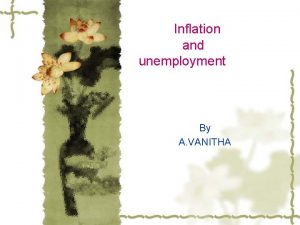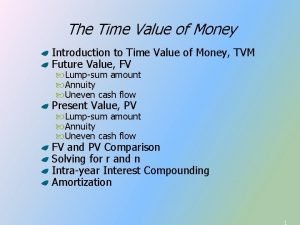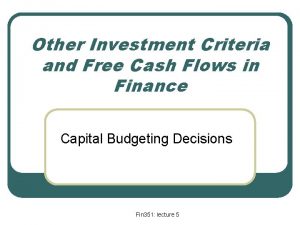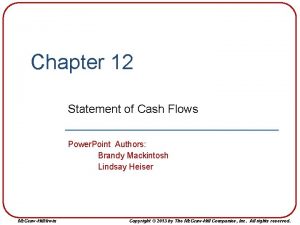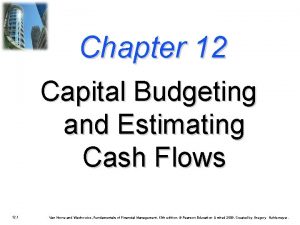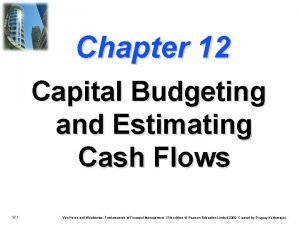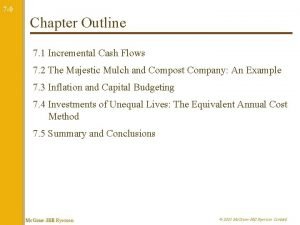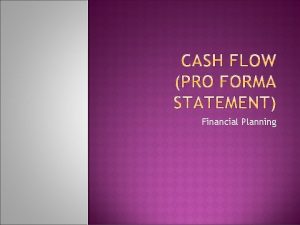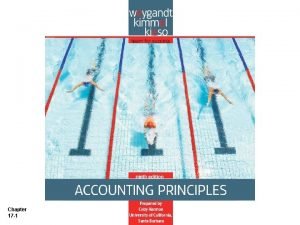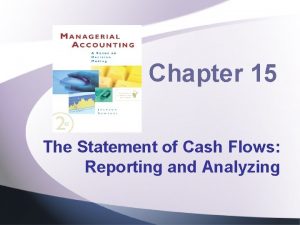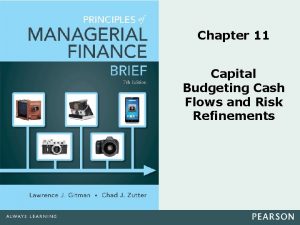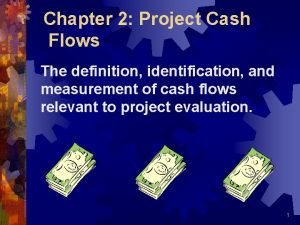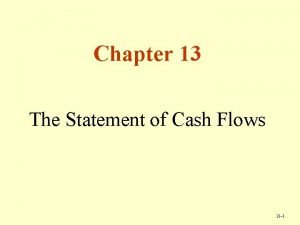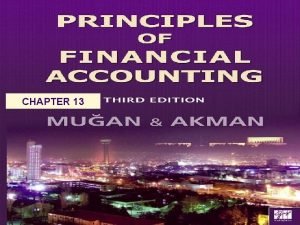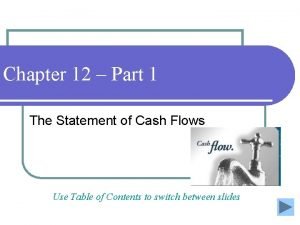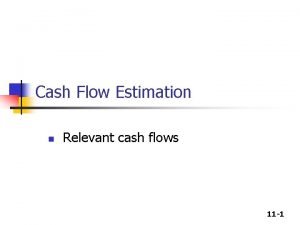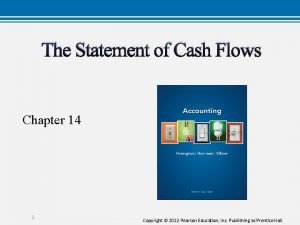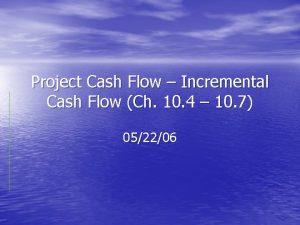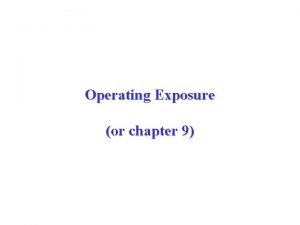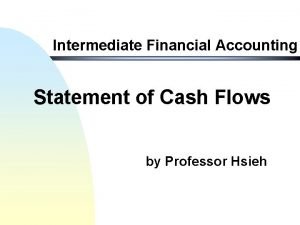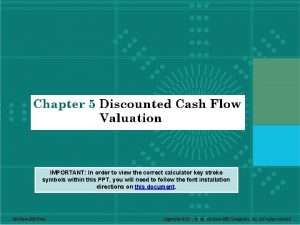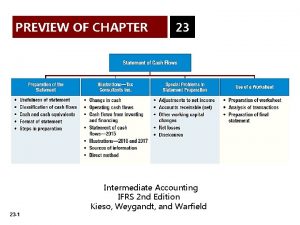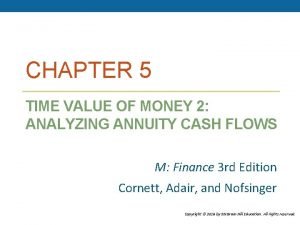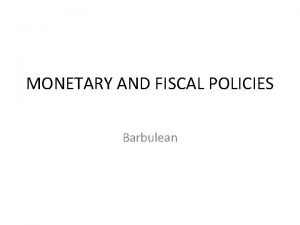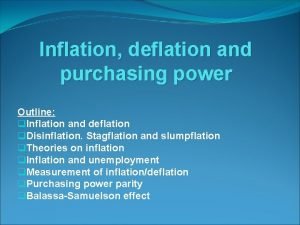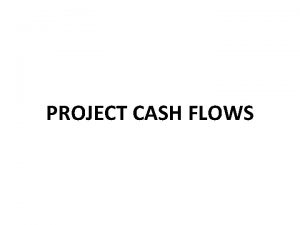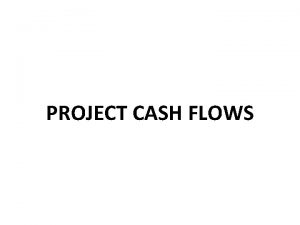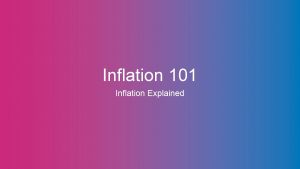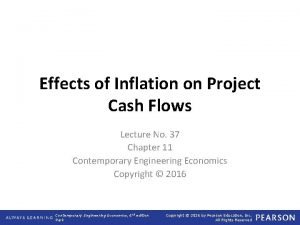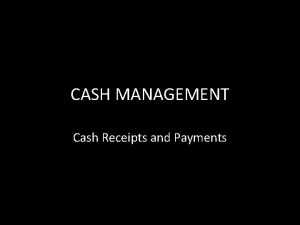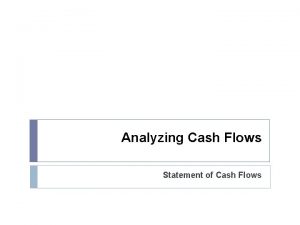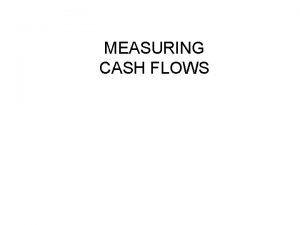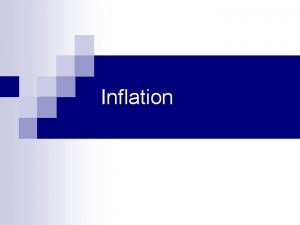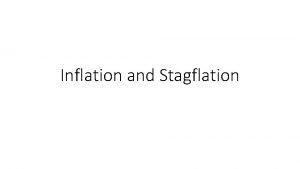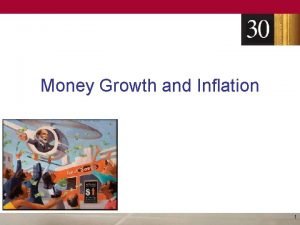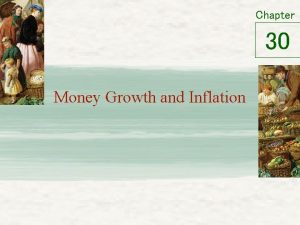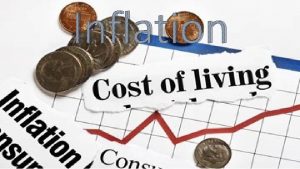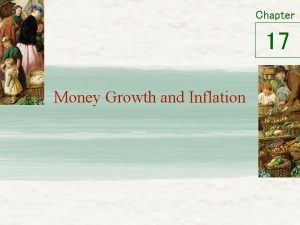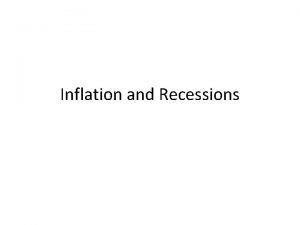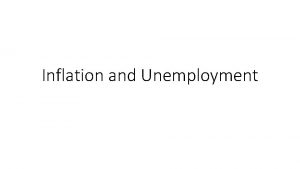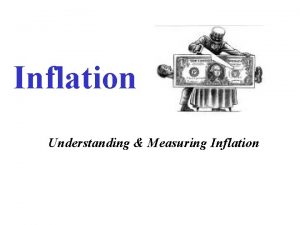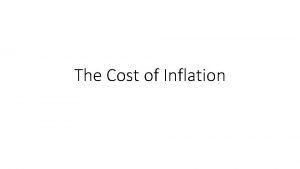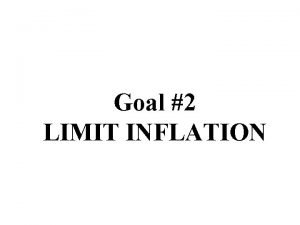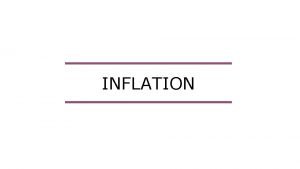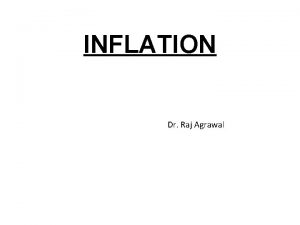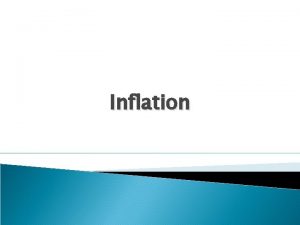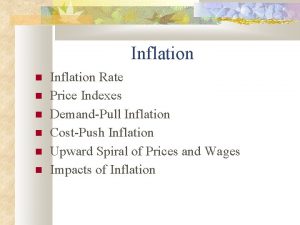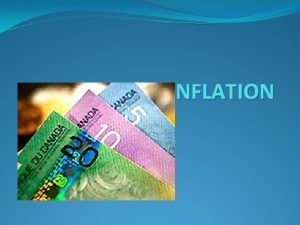Inflation and Its Effects on Project Cash Flows






































- Slides: 38

Inflation and Its Effects on Project Cash Flows Lecture No. 35 Chapter 11 Contemporary Engineering Economics Copyright © 2010 Contemporary Engineering Economics, 5 th edition, © 2010

What is Inflation? Definition: Inflation �Time Value of Money q. Earning Power is the rate at which q. Purchasing Power the general level of prices and goods and q Earning Power services is rising, and q. Investment Opportunity subsequently, purchasing power is q Purchasing Power falling. q. Decrease in purchasing power (inflation) q. Increase in purchasing power (deflation) Contemporary Engineering Economics, 5 th edition, © 2010

Inflation - Decrease in Purchasing Power $100 1990 You could buy 50 Big Macs in year 1990 with $100 $2. 00 / unit 2010 You can only buy 28. 5 Big Macs in year 2010. 75% Price change due to inflation $3. 50 / unit The $100 in year 2010 has only $57 worth purchasing power of 1990 Contemporary Engineering Economics, 5 th edition, © 2010

Deflation - Increase in Purchasing Power $100 2004 2005 $100 2006 2010 You could purchase 63. 69 gallons of purified drink water a year ago. $1. 57 / gallon 2004 2005 2006 2010 You can now purchase 80 gallons of purified drink water. 20. 38% $1. 25 / gallon Price change due to deflation Contemporary Engineering Economics, 5 th edition, © 2010

Inflation Terminology - I �Average Inflation Rate (f): a single average rate that accounts for the effect of varying yearly inflation rates over a period of several years. �Consumer Price Index: a statistical measure of change, over time, of the prices of goods and services in major expenditure groups—such as food, housing, apparel, transportation, and medical care—typically purchased by urban consumers �General Inflation Rate (f ): the average inflation rate calculated based on the CPI for all items in the market basket. Contemporary Engineering Economics, 5 th edition, © 2010

Average Inflation Rate (f ) Fact: q. Base Price = $100 (year 0) q. Inflation rate (year 1) = 4% q. Inflation rate (year 2) = 8% Find: Average inflation rate over 2 years? � Step 1: Find the actual inflated price at the end of year 2. $100 ( 1 + 0. 04) ( 1 + 0. 08) = $112. 32 � Step 2: Find the average inflation rate by solving the following equivalence equation. $100 ( 1+ f)2 = $112. 32 f = 5. 98% 0 $112. 32 1 2 $100 Contemporary Engineering Economics, 5 th edition, © 2010

Consumer Price Index (CPI): the CPI compares the cost of a sample “market basket” of goods and services in a specific period relative to the cost of the same “market basket” in an earlier reference period. This reference period is designated as the base period. �CPI (Old measure) – Base Period = 1967 � 2010 100 649. 10 (January) �CPI (New measure) – Base Period (1982 -84) � 1982 -84 � 2010 100 216. 68 (January) Contemporary Engineering Economics, 5 th edition, © 2010

Selected Price Indexes (Index for Base Year = 100, Calendar Month = April) Contemporary Engineering Economics, 5 th edition, © 2010

Example 11. 1 Average Inflation Rate Sample Calculation for Average Inflation rate for Gasoline: �Average Inflation Rate Given: P = 127. 3, F = 175. 3, N = 20092000 = 9. Find: f Contemporary Engineering Economics, 5 th edition, © 2010

General Inflation Rate (f) Formula: Calculation: �Given: �CPI for 2009 = 213. 2, �CPI for 2000 = 172. 2 �Find: f Contemporary Engineering Economics, 5 th edition, © 2010

Example 11. 2 Yearly and Average Inflation Rates q Year cost data: Year Cost 0 $504, 000 1 538, 000 2 577, 000 3 629, 500 �Solution: q Find: Yearly and Average inflation rates Contemporary Engineering Economics, 5 th edition, © 2010

Inflation Terminology – II �Actual Dollars (An ): Estimates of future cash flows for year n that take into account any anticipated future changes in amount caused by inflationary or deflationary effects. �Constant Dollars (An’ ): Estimates of future cash flows for year n in constant purchasing power, independent of the passage of time (or base period). Contemporary Engineering Economics, 5 th edition, © 2010

Finding Actual Dollars � Conversion from Constant to Actual Dollars � Example: General inflation rate = 5% Contemporary Engineering Economics, 5 th edition, © 2010

Finding Constant Dollars � Conversion from Actual to Constant dollars � Example 11. 4 - General inflation rate of 5% Contemporary Engineering Economics, 5 th edition, © 2010

Inflation Terminology - III �Inflation-free interest rate (i’): an estimate of the true earning power of money when the inflation effects have been removed (also known as real interest rate). �Market interest rate (i): an interest rate which takes into account the combined effects of the earning value of capital and any anticipated changes in purchasing power (also known as inflation-adjusted interest rate). Contemporary Engineering Economics, 5 th edition, © 2010

Inflation and Cash Flow Analysis q. Constant Dollar analysis q Estimate all future cash flows in constant dollars. q Use i’ as an interest rate to find the equivalent worth. q. Actual Dollar Analysis q Estimate all future cash flows in actual dollars. q Use i as an interest rate to find the equivalent worth. Contemporary Engineering Economics, 5 th edition, © 2010

When do we Prefer Constant Dollar Analysis? �In the absence of inflation, all economic analyses up to this point is, in fact, the constant dollar analysis. �Constant dollar analysis is common in the evaluation of many long-term public projects, because governments do not pay income taxes. �For private sector, income taxes are levied based on the taxable income in actual dollars, so the actual dollar analysis is more common. Contemporary Engineering Economics, 5 th edition, © 2010

Two Alternate Ways in Conducting Present Worth Analysis Using Actual Dollars • Method 1: Deflation Method - Step 1: Bring all cash flows to have common purchasing power. - Step 2: Consider the earning power. • Method 2: Adjusted-discount Method - Combine Steps 1 and 2 into one step. Contemporary Engineering Economics, 5 th edition, © 2010

Example 11. 6 – Deflation Method Step 1: Converting Actual Dollars into Step 2: Calculating Equivalent Constant Dollars Present Worth Contemporary Engineering Economics, 5 th edition, © 2010

Graphical Overview on Deflation Method (Example 11. 6): Converting actual dollars to constant dollars and then to equivalent present worth n=0 n=1 n=2 n=3 n=4 n=5 Actual Dollars Constant Dollars Present Worth -$75, 000 $32, 000 $35, 700 $32, 800 $29, 000 $58, 000 $30, 476 $32, 381 $28, 334 $23, 858 $45, 455 $28, 218 -$75, 000 $27, 706 $26, 761 $21, 288 $16, 295 $45, 268 Contemporary Engineering Economics, 5 th edition, © 2010

Adjusted-Discount Method – Perform Deflation and Discounting in One Step o Discrete Compounding Step 1 Step 2 o Continuous Compounding Contemporary Engineering Economics, 5 th edition, © 2010

Example 11. 7 Adjusted-Discounted Method Given: inflation-free interest rate = 0. 10, general inflation rate = 5%, and cash flows in actual dollars Find: i and NPW Contemporary Engineering Economics, 5 th edition, © 2010

Graphical Overview on Adjusted Discount Method: Converting actual dollars to present worth dollars by applying the market interest rate Actual Dollars Present Worth n=0 n=1 -$75, 000 $32, 000 n=2 n=3 n=4 $35, 700 $32, 800 $29, 000 $58, 000 $28, 218 -$75, 000 $27, 706 n=5 $26, 761 $21, 288 $16, 295 $45, 268 Contemporary Engineering Economics, 5 th edition, © 2010

Mixed-Dollar Analysis – College Savings Plan Equivalence Calculation with Composite Cash Flow Elements Approach: Convert any cash flow elements in constant dollars into actual dollars. Then use the market interest rate to find the equivalent present value. Assume f = 6% and i = 8% compounded quarterly. Age (Current Age = 5 Years Old) Estimated College Expenses in Today’s Dollars College Expenses Converted into Equivalent Actual Dollars 18 (Freshman) $30, 000(F/P, 6%, 13) = $63, 988 19 (Sophomore) 30, 000(F/P, 6%, 14) = 67, 827 20 (Junior) 30, 000(F/P, 6%, 15) = 71, 897 21 (senior) 30, 000(F/P, 6%, 16) = 76, 211 Contemporary Engineering Economics, 5 th edition, © 2010

Solution: Required Quarterly Contributions to College Funds V 1 = C(F/A, 2%, 48) V 2 = $229, 211 Let V 1 = V 2 and solve for C: C = $2, 888. 48 Contemporary Engineering Economics, 5 th edition, © 2010

Effects of Inflation on Project Cash Flows Contemporary Engineering Economics, 5 th editio, © 2010

Effects of Inflation on Projects with Depreciable Assets Item Effects of Inflation Depreciation expense is charged to taxable income in dollars of declining values; taxable income is overstated, resulting in higher taxes Salvage value Inflated salvage value combined with book values based on historical costs results in higher taxable gains. Note: Depreciation expenses are based on historical costs and always expressed in actual dollars Contemporary Engineering Economics, 5 th edition, © 2010

Example 11. 8 Reconsider the Automated Machining Center project discussed earlier. What will happen to this investment project if q the general inflation during the next five years is expected to increase by 5% annually, q sales, operating costs, and working capital requirements are assumed to increase accordingly, q depreciation will remain unchanged, but taxes, profits, and thus cash flow will be higher. q the firm’s inflation-free interest rate is known to be 15%. Determine the PW of the project. Contemporary Engineering Economics, 5 th edition, © 2010

Contemporary Engineering Economics, 5 th edition, © 2010

Effects of Borrowed Funds under Inflation Item Effects of Inflation Loan repayments Borrowers repay historical loan amounts with dollars of decreased purchasing power, reducing the debt-financing cost. Note: Loan expenses are always expressed in actual dollars! Contemporary Engineering Economics, 5 th edition, © 2010

Example 11. 10 Effects of Inflation on Payments with Financing q. Given: borrowing rate = 15. 5%, general inflation rate = 5%, and inflation-free interest rate = 15%, amount of borrowing = $62, 500 over 5 years q. Find: NPW q Market interest rate = 0. 15 + 0. 0075 = 20. 75% q NPW w/o borrowing = $38, 898 q NPW w borrowing = $54, 159 q The gain in NPW due to debt financing = $15, 261 Contemporary Engineering Economics, 5 th edition, © 2010

Effects of Inflation on Return on Investment Item Effects of Inflation Rate of Return and NPW Unless revenues are sufficiently increased to keep pace with inflation, tax effects and/or a working capital drain result in lower rate of return or lower NPW. Contemporary Engineering Economics, 5 th edition, © 2010

Example 11. 11 IRR Analysis with Inflation q. IRR in the absence of inflation q. IRR Calculation under Inflation Contemporary Engineering Economics, 5 th edition, © 2010

Rate of Return Analysis under Inflation �Principle: True (real) rate of return should be based on constant dollars. �If the rate of return is computed based on cash flows in actual dollars, the real rate of return can be calculated as: n Net cash flows in actual dollars 0 1 2 3 4 -$30, 000 13, 570 15, 860 13, 358 13, 626 IRR 31. 34% Contemporary Engineering Economics, 5 th edition, © 2010 Net cash flows in constant dollars -$30, 000 12, 336 13, 108 10, 036 9, 307 19. 40%

Decision Criterion �If you use 31. 34% as your IRR, you should use a market interest rate (or inflation-adjusted MARR) to make an accept and reject decision. �If you use 19. 40% as your IRR, you should use an inflation-free interest rate (inflation-free MARR) to make an accept and reject decision. In our example, MARR’ = 20%. Contemporary Engineering Economics, 5 th edition, © 2010

Effects of Inflation on Working Capital Item Effects of Inflation Working capital requirement Known as working capital drain, the cost of working capital increases in an inflationary environment. Contemporary Engineering Economics, 5 th edition, © 2010

Example 11. 12 Effects of Inflation on Working Capital Contemporary Engineering Economics, 5 th edition, © 2010

Working Capital Requirements under Inflation Contemporary Engineering Economics, 5 th edition, © 2010
 Operating budget example
Operating budget example Introduction of inflation
Introduction of inflation Inflation causes
Inflation causes Pv of cash flows formula
Pv of cash flows formula Incremental cash flows
Incremental cash flows Discounted payback period formula
Discounted payback period formula Cash flow indirect method
Cash flow indirect method How to calculate incremental cash flows
How to calculate incremental cash flows Incremental cash flows
Incremental cash flows Working capital investment example
Working capital investment example Examples of incremental cash flows
Examples of incremental cash flows Partial statement of cash flows
Partial statement of cash flows Operating investing and financing activities
Operating investing and financing activities Pro forma statement of cash flows
Pro forma statement of cash flows Prepaid expenses cash flow statement
Prepaid expenses cash flow statement The statement of cash flows reports
The statement of cash flows reports Chapter 11 capital budgeting cash flows solutions
Chapter 11 capital budgeting cash flows solutions Juarez company acquired $1 200
Juarez company acquired $1 200 Granting credit to customers
Granting credit to customers Chapter 23 statement of cash flows
Chapter 23 statement of cash flows Relevant cash flows definition
Relevant cash flows definition The statement of cash flows classifies items as
The statement of cash flows classifies items as Chapter 13 statement of cash flows
Chapter 13 statement of cash flows Flow chapter 13
Flow chapter 13 The statement of cash flows helps users
The statement of cash flows helps users Relevant cash flows
Relevant cash flows Statement of cash flows partial
Statement of cash flows partial Incremental cash flow analysis
Incremental cash flow analysis What is operating exposure
What is operating exposure Intermediate cash flows
Intermediate cash flows Ear formula
Ear formula Chapter 23 statement of cash flows
Chapter 23 statement of cash flows Future value of multiple cash flows example
Future value of multiple cash flows example The statement of cash flows helps users
The statement of cash flows helps users Intermediate accounting chapter 23
Intermediate accounting chapter 23 Future value of multiple cash flows example
Future value of multiple cash flows example Nortmative
Nortmative Negative effects of inflation
Negative effects of inflation Negative effects of inflation
Negative effects of inflation

